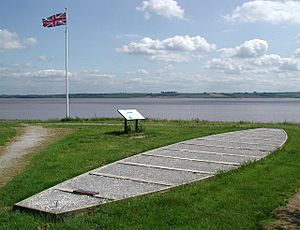Ferriby Boats facts for kids

The Ferriby Boats are three very old boats from the Bronze Age in Britain. They were found near North Ferriby in Yorkshire, England. These boats are special because they were built by "sewing" planks of wood together.
They are some of the oldest boats of their kind found in Britain. In fact, they are the earliest known sewn-plank boats found in Europe. They are also the oldest sewn-plank boats in the world, outside of ancient Egypt!
Contents
History of the Boats
Ferriby is located right next to the Humber estuary, which flows into the North Sea. This has made people wonder if these ancient boats were used to sail across the sea to other countries. We know that people traveled between Britain and Europe during the Bronze Age. However, we don't know exactly what kind of boats they used for these long journeys.
Some experts believe the Ferriby boats could have crossed the North Sea. They might have carried tons of goods! But by today's standards, these boats seem best for calm waters.
There's a bit of a debate about whether they were truly "seagoing." Another famous ancient boat, the Dover Bronze Age Boat, is thought by some to be the oldest boat made for sea travel. This is because the Ferriby boats didn't have a pointed front or a curved bottom like some later boats. However, others disagree! The museum that now has the Ferriby boats says they did have curved bottoms, which would have helped them at sea.
Finding the Ferriby Boats
The Ferriby Boats were discovered over many years by a man named Ted Wright and his family.
Ferriby Boat 1
In 1937, Ted Wright and his brother Will found the first boat, called Ferriby Boat 1 (or F1). They found it on the shore of the Humber. It was the bottom part of a boat, almost complete. It was about 1.7 meters (5.7 feet) wide and over 13 meters (43 feet) long! The planks were thick, about 3-4 inches.
This boat was made from oak wood. The planks were "stitched" together using strong yew branches. Gaps were filled with moss to make them watertight. Scientists have used radiocarbon dating to figure out its age. It was built between 1880 and 1680 BC. It was big enough for up to eighteen paddlers!
Ferriby Boat 2
Just a short distance away, Ted Wright found a piece of a second boat in 1940. This became known as Ferriby Boat 2 (or F2). It was dated to be from between 1940 and 1720 BC.
Ferriby Boat 3
In 1963, Ted Wright, along with his son Roderick, found a third boat. This one was found right next to Ferriby Boat 1. Many years later, in the late 1990s, scientists used special tests to find out that this boat was the oldest of them all! It dated back to 2030 BC. Ted Wright had actually thought this might be the case much earlier.
Where to See Them
The original parts of the Ferriby Boats were dug up in 1946. They had to be cut into pieces to be moved safely. For a while, they were kept at the National Maritime Museum in Greenwich. Now, they are looked after by Hull Museums. You can also find information about the boats on a special board at Ferriby foreshore, along a public walking path.
Building Replicas
People have made two different copies, or "replicas," of the Ferriby Boats to learn more about them.
Oakleaf
In 2002-2003, a team led by Edwin Gifford built a half-size copy of a Ferriby boat called Oakleaf. They even tried putting a sail on it, even though there's no proof the original boats had sails. The Oakleaf sailed successfully! In 2008, the Ferriby Heritage Trust got the Oakleaf, and it is now kept at Ferriby.
Morgawr
Between 2012 and 2013, a full-size working copy of Ferriby Boat 1 was built. It was named Morgawr. This project was a team effort between the National Maritime Museum Cornwall and the University of Exeter. It was a type of experimental archaeology. This means they built it using tools like those from the Bronze Age to learn how the original boats were made.
Morgawr was launched in Falmouth Harbour in March 2013. Its first trip was paddled by the volunteers who built it. A rowing club team also tested how well it could move and how fast it could go. In 2014, after being in the water for many months, Morgawr was taken out for inspection. As of 2016, you can see it on display next to the Maritime Museum.
Tree-Ring Research
In 1985, scientists looked at the tree rings from all three boats. Tree rings can tell us about the age of the wood. It was hard to get exact dates because the boats had already been treated. However, they did find some interesting things. For example, two of the bottom planks came from the same tree. Also, boats 1 and 2 might have been made from trees cut down at the same time, even though other tests suggest they were from different times.
See also



